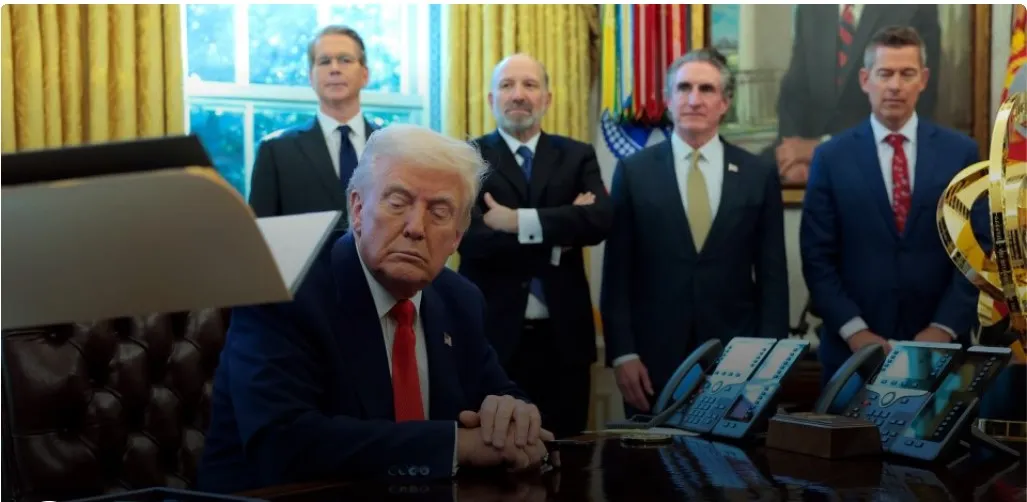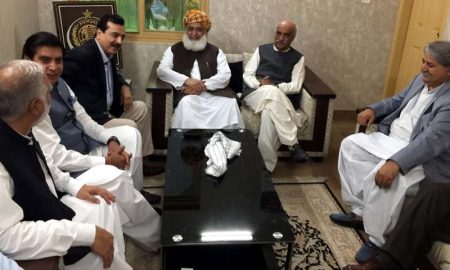Washington/Islamabad, April 10: In a surprising shift, President Donald Trump announced a three-month suspension of his much-publicized reciprocal tariff policy, highlighting his threshold for political backlash in a single week.
“They were getting a little yippy,” Trump said, referencing the growing criticism from political allies, business leaders, and even personal confidants.
The policy reversal came just one day after Trump had publicly stood firm behind the tariffs, even as his own U.S. Trade Representative was testifying on their benefits before Congress — unaware of the looming pause.
Despite repeated pleas from party members and economic stakeholders, Trump had been unwavering, stating: “MY POLICIES WILL NEVER CHANGE.”
However, mounting market volatility, especially in the bond market, ultimately tipped the scales. A selloff in U.S. Treasury securities — typically a safe investment — raised alarms across the administration and led to urgent deliberations.
Treasury Secretary Scott Bessent addressed these concerns directly with Trump on Wednesday morning. The meeting followed heightened anxiety within the Treasury Department regarding falling bond prices and weak demand at a key government auction.
These developments indicated that international investors were pulling back, potentially undermining the U.S. government’s ability to fund itself.
As concerns escalated, calls from major business figures and Republican leaders flooded the White House. Their message: the economic costs of the tariff plan outweighed its intended benefits.
JP Morgan Stance
Fox Business, often favored by Trump, aired warnings from prominent voices like JPMorgan CEO Jamie Dimon, who predicted a possible recession if trade tensions escalated.
Initially, Trump had not decided to hit pause. But later that day, observing the financial fallout and internal pressure, he posted on Truth Social announcing the delay — a move that surprised even top White House officials, many of whom found out at the same time as the public.
Also Read: Trump Presses 90-Day Tariff Pause Button for Most Countries
Trump was in the Oval Office when he drafted the post, flanked by two of his key trade advisors: Treasury Secretary Bessent and Commerce Secretary Howard Lutnick. According to Trump, the announcement wasn’t the product of legal consultations but was “written from the heart.”
Although markets responded positively to the pause, Trump also introduced new uncertainty by hinting at potential exemptions for certain U.S. firms — decisions he said he would make based on instinct.
The rapid sequence of events created another chaotic Wednesday at the White House, with advisors scrambling to keep up.
Trump tried to spin the retreat as a victory, taking credit for market gains while ignoring the significant losses of the previous week. “It’s the biggest increase in the history of the stock market,” Trump said. “If we keep it up, we’ll be back to where we were four weeks ago.”
Many staffers were unaware of the policy shift until Trump’s social media post. U.S. Trade Representative Jamieson Greer appeared caught off guard during a Capitol Hill hearing, where he defended the tariffs just as the announcement went live.
Critics pointed out the policy reversal undermined credibility. However, Bessent claimed the move was not a retreat but rather a calculated part of a broader strategy.
“This was his plan from the beginning,” Bessent stated, highlighting Trump’s intention to bring global players to the negotiation table.
Despite this framing, Trump admitted the criticism and market volatility were major influences. “People were jumping a little out of line,” he said to reporters.
Read More: Negligible Direct Impact on Pakistan: Trump Tariffs Determination
The Treasury team’s intense focus on the bond market began early Wednesday, as the selloff worsened. Instead of rallying — as U.S. bonds typically do during global instability — Treasuries saw accelerated selling.
Alarm peaked after a weak auction for new government debt, sparking fears that foreign buyers were backing out of the U.S. bond market altogether.
Since these sales help finance government operations beyond tax revenues, the implications were significant.
Market Voices
In interviews, Bessent tried to downplay the market reaction as “uncomfortable, but normal.”
However, his background in finance and deep knowledge of bond markets allowed him to grasp the magnitude of the problem. That understanding shaped his later conversation with Trump, leading to the policy pause.
Meanwhile, Trump monitored media coverage closely. Having seen allies warn of a looming recession, he took particular note of Jamie Dimon’s televised comments. “Markets aren’t always right, but sometimes they are,” Dimon warned.
Behind the scenes, White House phone lines were swamped with calls from business leaders, party officials, and economic advisors. Calls to key figures like Chief of Staff Susie Wiles, Vice President JD Vance, and Treasury Secretary Bessent focused on persuading Trump to reconsider.
Wiles, in particular, emphasized the political cost of a prolonged market slump and how it might endanger the administration’s broader agenda.
Bessent, who had spent the previous weekend in Florida discussing the tariff strategy with Trump, took a lead role in public messaging. “Dozens of countries are now seeking trade deals. This is the result of the president’s vision,” he said.
Also Read: Trump Tariffs on Chinese Goods Hit 104%, Pakistan 29%, Markets React Globally
Despite the spin, Trump made it clear he had been following the markets closely. “The bond market’s tricky,” he admitted. “I saw people getting a little queasy.”
One week after announcing tariffs that shocked the global trading system, Trump stood outside the White House, flanked by race cars, reflecting on what many saw as one of his most dramatic policy retreats.
He was unapologetic, defending his flexibility and reframing the pause as a strategic maneuver.
“You’ve got to be flexible,” he concluded. “Financial markets change — just look at how much they changed today.”









